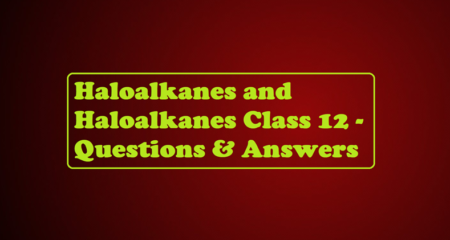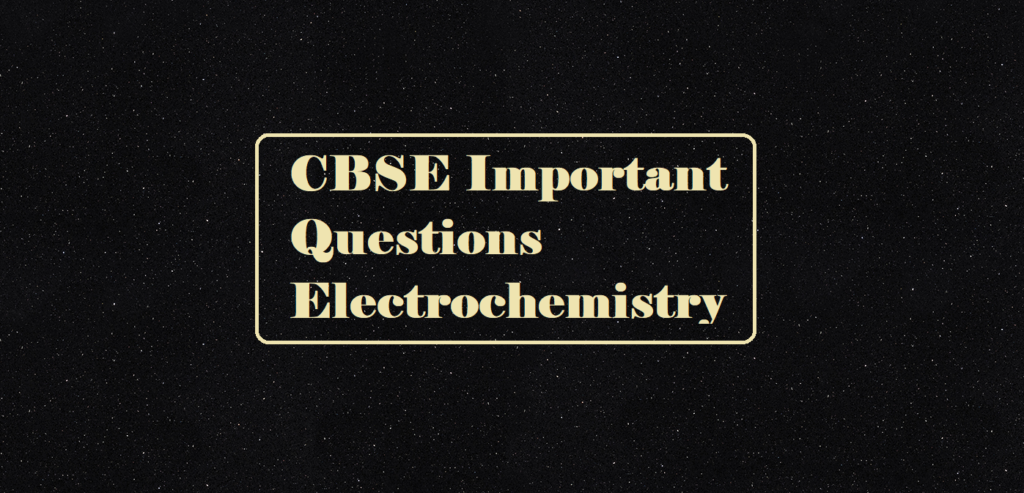Case Study Questions Haloalkanes and Haloarenes Class 12 Chemistry
Case Study Questions Haloalkanes and Haloarenes Class 12 Chemistry
1. Read the passage given below and answer the following questions:
Nucleophilic substitution reactions are of two types; substitution nucleophilic bimolecular (SN2) and substitution nucleophilic unimolecular (SN1) depending on molecules taking part in determining the rate of reaction. The reactivity of alkyl halide towards SN1 and SN2 reactions depends on various factors such as steric hindrance, stability of intermediate or transition state, and polarity of the solvent. SN2 reaction mechanism is favoured mostly by primary alkyl halide or transition state and polarity of the solvent, SN2 reaction mechanism is favoured mostly by primary alkyl halide then secondary and then tertiary. This order is reversed in the case of SN1 reactions.
(i) Which of the following is most reactive towards nucleophilic substitution reaction?
(a) C6H5Cl
(b) CH2 = CHCl
(c) ClCH2CH = CH2
(d) CH3CH = CHCl
(ii) Isopropyl chloride undergoes hydrolysis by
(a) SN1 mechanism
(b) SN2 mechanism
(c) SN1 and SN2 mechanism
(d) Neither SN1 nor SN2 mechanism
(iii) Tertiary alkyl halides are practically inert to substitution by SN2 mechanism because of
(a) Insolubility
(b) Instability
(c) Inductive effect
(d) Steric Hindrance
(iv) Which of the following is the correct order of decreasing SN2 reactivity?
(a) RCH2X > R2CHX > R3CX
(b) R3CX > R2CHX >RCH2X
(c) R2CHX > R3CX > RCH2X
(d) RCH2X > R3CX > R2CHX
(v) An organic molecule necessarily shows optical activity if it-
a) Contains asymmetric carbon atoms
b) Is non-polar
c) Is non-superimposable on its mirror image
d) Is superimposable on its mirror image.
Case Study Questions Haloalkanes and Haloarenes Class 12 Chemistry
2. Read the passage given below and answer the following questions:
The replacement of hydrogen atom in a hydrocarbon, aliphatic or aromatic results in the formation of haloalkanes and haloarenes respectively. Haloalkanes contain a halogen atom attached to sp3 hybridized carbon atom of an alkyl group whereas haloarenes contain a halogen atom attached to sp2 hybridized carbon atom of an aryl group. Haloalkanes and haloarenes may be classified on the basis of the number of halogen atoms in their structures as mono, di, or poly halogen compounds and also on the basis of the state of hybridization of the carbon atom to which the halogen atom is bonded.
(i) Which of the following halide is 2°?
(a) Isopropyl chloride
(b) Isobutyl chloride
(c) n-propyl chloride
(d) n-butyl chloride
(ii) Which of the following is a Gem-dibromide is:
(a) CH3CH(Br)CH2(Br)
(b) CH3CBr2CH3
(c) CH2(Br)CH2CH2
(d) CH2BrCH2Br
(iii) IUPAC name of (CH3)3CCl is:
(a) 3-Chlorobutane
(b) 2-Chloro-2-methylpropane
(c) t-butyl chloride
(d) n-butyl chloride
(iv) Which of the following is a primary halide?
(a) Isopropyl iodide
(b) Secondary butyl iodide
(c) Tertiarybutyl bromide
(d) Neohexyl chloride
(v) Which one of the following is not an allylic halide?
(a) 4-Bromopent-2-ene
(b) 3-Bromo-2-methylbut-1-ene
(c) 1-Bromobut-2-ene
(d) 4-Bromobut-1-ene
Case Study Questions Haloalkanes and Haloarenes Class 12 Chemistry
3. Read the passage given below and answer the following questions:
Alkyl halides are prepared by the free radical halogenation of alkanes, addition of halogen acids to alkenes, replacement of -OH group of alcohols with halogens using phosphorus halides, thionyl chloride, or halogen acids. Aryl halides are prepared by electrophilic substitution to arene. Fluorine and iodides are best prepared by the halogen exchange method. These compounds find wide applications in industry as well as in day-to-day life. These compounds are generally used as solvents and as starting materials for the synthesis of a large number of organic compounds.
(i) The best method for the conversion of an alcohol into an alkyl chloride is by treating the alcohol with
(a) PCl5
(b) Dry HCl in the presence of anhydrous ZnCl2
(c) SOCl2 in presence of pyridine
(d) None of these
(ii) The catalyst used in the preparation of an alkyl chloride by the action of dry HCl on alcohol is
(a) anhydrous AlCl3
(b) FeCl3
(c) anhydrous ZnCl2
(d) Cu
(iii) An alkyl halide reacts with metallic sodium in dry ether. The reaction is known as:
(a) Frankland’s reaction
(b) Sandmeyer’s reaction
(c) Wurtz reaction
(d) Kolbe’s reaction
(iv) Fluorobenzene (C6H5F) can be synthesized in the laboratory
(a) By direct fluorination of benzene with F2 gas
(b) By reacting bromobenzene with NaF solution
(c) By heating phenol with HF and KF
(d) From aniline by diazotization followed by heating the diazonium salt with HBF4
Case Study Questions Haloalkanes and Haloarenes Class 12 Chemistry



